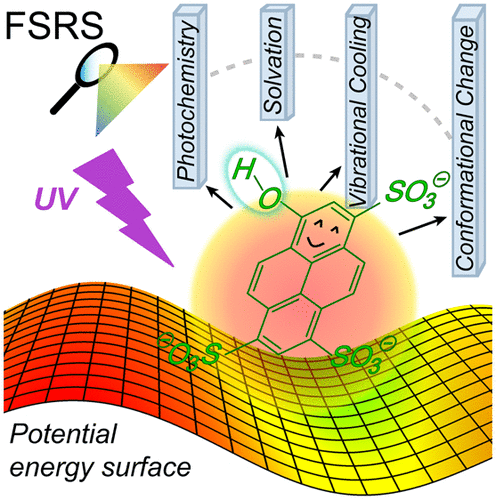当前位置:
X-MOL 学术
›
J. Phys. Chem. Lett.
›
论文详情
Our official English website, www.x-mol.net, welcomes your
feedback! (Note: you will need to create a separate account there.)
Correlated Molecular Structural Motions for Photoprotection after Deep-UV Irradiation
The Journal of Physical Chemistry Letters ( IF 4.8 ) Pub Date : 2018-04-19 00:00:00 , DOI: 10.1021/acs.jpclett.8b00999 Longteng Tang 1 , Yanli Wang 1 , Liangdong Zhu 1 , Che Lee 1 , Chong Fang 1
The Journal of Physical Chemistry Letters ( IF 4.8 ) Pub Date : 2018-04-19 00:00:00 , DOI: 10.1021/acs.jpclett.8b00999 Longteng Tang 1 , Yanli Wang 1 , Liangdong Zhu 1 , Che Lee 1 , Chong Fang 1
Affiliation

|
Exposure to ultraviolet (UV) light could cause photodamage to biomolecular systems and degrade optoelectronic devices. To mitigate such detrimental effects from the bottom up, we strategically select a photosensitive molecule pyranine and implement femtosecond electronic and Raman spectroscopies to elucidate its ultrafast photoprotection mechanisms in solution. Our results show that pyranine undergoes excited-state proton transfer in water, while this process is blocked in methanol regardless of excitation wavelengths (267, 400 nm). After 267 nm irradiation, the molecule relaxes from a higher lying electronic state into a lower lying singlet state with a <300 fs time constant, followed by solvation events. Transient Raman marker bands exhibit different patterns of intensity dynamics and frequency shift that elucidate the real-time interplay among conformational motions, photochemical reaction, and vibrational cooling after excitation. More energetic photons are revealed to selectively enhance certain relaxation pathways. These mechanistic findings offer new guidelines to improve the UV tolerance and stability of the engineered functional molecules in materials and life sciences.
中文翻译:

紫外线照射后光防护的相关分子结构运动
暴露于紫外线(UV)可能会对生物分子系统造成光损坏,并降低光电器件的性能。为了从下至上减轻这种不利影响,我们从战略上选择了光敏分子吡喃,并实施了飞秒电子和拉曼光谱,以阐明其在溶液中的超快光保护机理。我们的结果表明,吡喃烷在水中会发生激发态质子转移,而无论激发波长(267,400 nm),该过程都在甲醇中受阻。267 nm辐照后,分子以<300 fs的时间常数从高位电子态松弛到低位单线态,随后发生溶剂化事件。瞬态拉曼标记带表现出不同的强度动力学和频移模式,阐明了构象运动,光化学反应和激发后的振动冷却之间的实时相互作用。揭示出更多的高能光子可以选择性地增强某些弛豫途径。这些机理发现为改善材料和生命科学中工程功能分子的紫外线耐受性和稳定性提供了新的指导原则。
更新日期:2018-04-19
中文翻译:

紫外线照射后光防护的相关分子结构运动
暴露于紫外线(UV)可能会对生物分子系统造成光损坏,并降低光电器件的性能。为了从下至上减轻这种不利影响,我们从战略上选择了光敏分子吡喃,并实施了飞秒电子和拉曼光谱,以阐明其在溶液中的超快光保护机理。我们的结果表明,吡喃烷在水中会发生激发态质子转移,而无论激发波长(267,400 nm),该过程都在甲醇中受阻。267 nm辐照后,分子以<300 fs的时间常数从高位电子态松弛到低位单线态,随后发生溶剂化事件。瞬态拉曼标记带表现出不同的强度动力学和频移模式,阐明了构象运动,光化学反应和激发后的振动冷却之间的实时相互作用。揭示出更多的高能光子可以选择性地增强某些弛豫途径。这些机理发现为改善材料和生命科学中工程功能分子的紫外线耐受性和稳定性提供了新的指导原则。











































 京公网安备 11010802027423号
京公网安备 11010802027423号